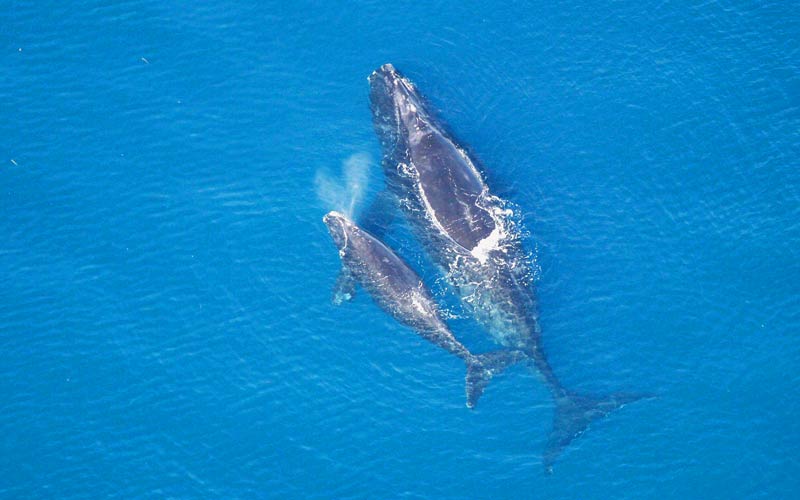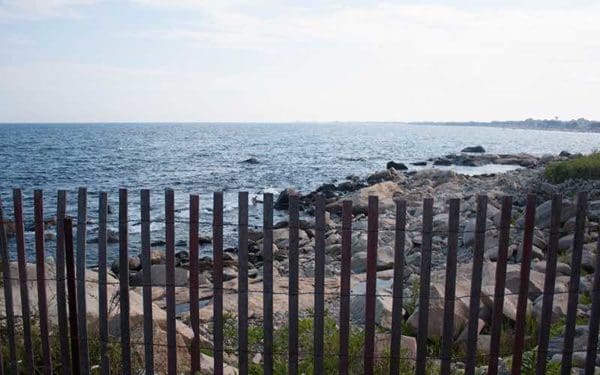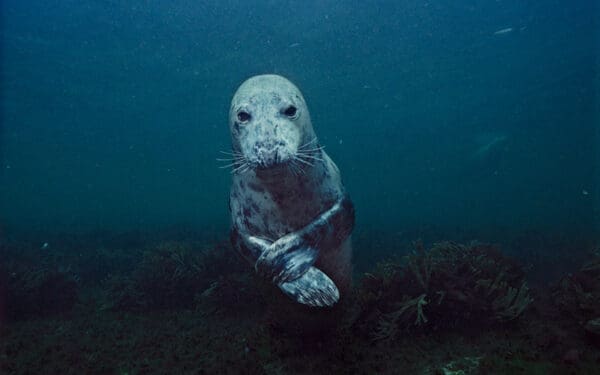
North Atlantic right whales help our climate and make our ocean more resilient. We must push for better protections to protect our valuable partners in this fight. Photo: National Oceanic and Atmospheric Administration (NOAA), U.S. Department of Commerce.
We have a rarely acknowledged partner helping in our fight to solve climate change: the critically endangered North Atlantic right whale.
From the second they are born to their last breath, North Atlantic right whales help our environment. These large, majestic creatures – which can grow to the size of a school bus – call the coastal waters of the eastern United States home. Traveling as far north as Canada and as far south as Florida, they are both our neighbors and environmental champions.
Just by existing, right whales make our ocean more resilient.
However, the population of this majestic species is in decline, with less than 356 right whales left on the planet. Here are just three reasons why we must take urgent action to ensure that these climate champions survive to fight another day.
#1 Whale Plumes Fertilize Microorganisms Critical to a Healthy Ocean and Climate
As many babies do, North Atlantic right whale calves eat, sleep, and, inevitably, poop. As early as the day of their birth and continuing throughout their lifetimes, whales’ fecal plumes (a gassy form of underwater poop) give back to the environment in the form of ocean fertilizer. Whale feces also improve the health and ability of the ocean to remove carbon pollution.
Here’s how.
Rich in iron and nitrogen, fecal plumes help feed tiny creatures called phytoplankton. Thanks to these nutrients, phytoplankton absorb 40% of all carbon dioxide from the atmosphere. They also produce 50% of the world’s oxygen. That means that every other breath we take is thanks to these microorganisms.
And, research shows that just a 1% increase in phytoplankton activity would remove hundreds of millions of tons of carbon pollution a year – the equivalent of planting two billion trees. More and healthier right whales would help boost that phytoplankton activity – and, in turn, help address the climate crisis.
#2 Whales Also Fertilize Phytoplankton through Their Migration and Feeding Patterns
Right whales also help our climate by distributing nutrients around the ocean. Through their movements – vertically and horizontally – whales transport critical nutrients in their urine, placenta, and even dead skin.
First, let’s look at their vertical movements. Right whales feed at lower depths and come to the surface to breathe and poop. Through this pattern of diving and surfacing, they move vital minerals and nutrients up and down the water column. Scientists call this vertical movement the “whale pump.”
Some right whales also migrate annually from their nutrient-rich feeding grounds in Southern New England to their calving grounds on the coast of Florida, where nutrients are scarce. Known as the “whale conveyor belt,” this horizontal migration cycle keeps nutrients moving across the ocean.
Like whale feces, the “whale pump” and “conveyor belt” fuel the growth of phytoplankton. Without these processes, nutrients would sink and settle on the ocean floor – out of reach of other important marine life.
#3 Whale Falls Keep Carbon Out of the Atmosphere
Even after their last breath, North Atlantic right whales act to mitigate climate change through something called carbon sequestration – a process that removes carbon from the atmosphere.
North Atlantic right whales can live up to 75 years. And, over their lifetimes, they accumulate tons of carbon in their bodies. When a whale dies, its body – along with the carbon it absorbed – sinks to the bottom of the seafloor. This is called a “whale fall.”
That carbon is then released slowly over hundreds of years. To put this into perspective, some whales can store about 33 tons of carbon dioxide – more than 1,500 times the amount that a tree can absorb.
Today, however, right whales only live for about 65 years – with females living only for about 45 years. As a result, they capture far less carbon pollution than they could. Restoring the right whale population to a healthy level will mean we would have more whales, living longer, who will absorb many more tons of carbon dioxide than the species can today.
Overall, the importance of an individual whale cannot be overstated. The International Monetary Fund estimates that the contributions of one single whale to the environment could be valued at more than $2 million.
A Persevering Species
Sadly, the role of North Atlantic right whales as climate champions is in jeopardy. Since 2017, these whales have died at an alarming rate. With only less than 356 animals left in the world, of which less than 90 are females that can have calves, their numbers are declining too fast for the species to survive. And, the two main threats to that survival – vessel collisions and entanglements in fishing gear – both result from human activities. And, both are preventable with federal action.
Saving a Partnership for Life
We can and must follow many paths to stop climate change. But regardless of the paths we choose, let’s not forget our partners, the North Atlantic right whales. Even as climate change and human threats continue to affect their lives, these whales keep taking care of the environment day in and day out. And we need to push for their protection so that they can do their part to mitigate climate change and help create a greater future for all.
As environmental advocates, CLF is working hard to save right whales. We are asking federal agencies to immediately enact regulations that secure the future of this species. By pushing for better policies and more funding to safeguard these animals, we can protect their habitats and lives just as much as they sustain the climate and health of our planet.
[widget id=”clf_cta_widget-6″]



